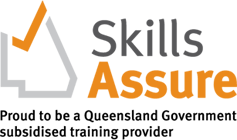Creating a strong cover letter is essential for getting a disability support worker job. It’s a chance to demonstrate how your background suits the unique requirements of supporting individuals with disabilities.
Passion for the work is also a significant factor in the disability support industry. Your cover letter allows you to communicate your enthusiasm, commitment, and genuine desire to make a positive impact on the lives of individuals with disabilities. To pique the interest of a hiring manager, you must craft a well-structured cover letter.
Sage Education can help enhance your cover letter by offering courses suitable for disability worker professionals. With these courses, you can build up your experience and showcase that in the cover letter.
Before delving into the specifics, it’s essential to understand the basic structure of this professional document. Keep reading our guide to learn how to write a cover letter for disability support worker jobs.
Understanding Disability Support Worker Roles
Disability support workers play a crucial role in enhancing the quality of life for individuals facing various physical, intellectual, or sensory challenges. Their responsibilities extend beyond conventional caregiving, as the role encompasses emotional support, skill development, and fostering independence.
The role involves providing personalised care tailored to the unique needs of each individual. This includes assistance with daily activities, such as personal hygiene, meal preparation, and mobility support. Empathy and compassion are essential as support workers build meaningful relationships and empower individuals to navigate life with confidence.
Staying informed about the evolving trends of disability support in Australia is essential. This also means staying up to date with the National Disability Insurance Scheme (NDIS). Disability support workers must ensure that their clients have access to the resources and opportunities necessary for a fulfilling life.
Researching the Employer
Before writing your cover letter for a disability support worker position in Australia, it’s essential to delve into the specifics of the employer. Demonstrating a genuine understanding of the organisation reflects your commitment and helps tailor your application to their unique needs.
Tips for researching the employer include:
– Explore the company’s website: Start by thoroughly exploring the employer’s website. This means taking note of their mission, values, and any recent achievements or initiatives related to disability support.
– Review their social media: Check the organisation’s social media profiles. Look for posts, events, or partnerships that showcase their commitment to the disability support community.
– Understand the organisation’s culture: You should gain insight into the workplace culture. This can be inferred from employee testimonials, company events, or any diversity and inclusion initiatives.
Contact Information and Cover Letter Header
Your contact information is the first impression you make on a potential employer. Therefore, you must make sure this information is clear and professional. Add your name, address, phone number, and email to the top of the cover letter.
Underneath the cover letter header, you can also create a compelling statement. This might be a personal statement that gives the employer an insight into your morals and goals. Adding this personal touch encourages the hiring manager to read your cover letter. You could discuss how much disability support work means to you and why you chose this particular career.
Opening Paragraph
The opening paragraph should be intriguing, as it will determine whether the employer will keep reading. You must use this as a way to introduce yourself and demonstrate your passion for the disability support worker role.
Here are some things to include:
Express your genuine interest
You should begin your cover letter by expressing your genuine interest in the disability support worker position. This means using a confident and positive tone to convey enthusiasm for the opportunity.
Mention the job title and description
Don’t forget to clearly state the specific position you are applying for, such as “Disability Support Worker.” Also, mention where you found the job posting, whether it’s on the company’s website, a job board, or through a referral. This shows that you have been actively searching for that particular role.
Connect with the organisation
Demonstrate that you’ve done your research by briefly mentioning why you are interested in working for the specific organisation. You can highlight any aspects of the company’s mission, values, or initiatives that resonate with your own professional goals.
Showcasing Relevant Skills and Experience
Your cover letter is your opportunity to shine by showcasing the skills and experiences that make you an ideal fit for the role of a disability support worker. Here’s a guide on how to effectively highlight your key strengths:
Empathy and compassion
You should begin by sharing a specific experience that demonstrates your ability to empathise with individuals facing challenges. Whether it’s a heartwarming story from a previous role or a personal connection, you can make it relatable and impactful.
Example:
Throughout my career, I have improved my empathy skills to support individuals facing diverse challenges. During my time at [Previous Job], I actively engaged with clients with varying needs, fostering a deep sense of compassion. One particular instance stands out when I supported a young individual in overcoming communication barriers, which helped us build a trusting relationship that significantly improved their overall well-being.
Effective communication
It’s essential to outline instances where your communication skills played a crucial role in your job. This could involve collaboration with a multidisciplinary team, explaining complex information to clients and families, or any other scenario where your communication skills were important.
Example:
In my previous role at [Previous Job], I successfully collaborated with a multidisciplinary team to ensure seamless information exchange and coordination of care plans. Whether it was facilitating communication between healthcare professionals or conveying complex information to clients and their families, my ability to communicate effectively has been a cornerstone of my professional journey.
Problem-solving and adaptability
Showcase your problem-solving mindset and adaptability skills. You can explain situations where you navigated unforeseen challenges, proving your ability to think on your feet and ensure continuity of care.
Example:
In a fast-paced environment at [Previous Job], I encountered unforeseen challenges regularly. These situations demanded quick thinking and adaptability to ensure the continuity of care. I thrive in such dynamic settings, and my experience has equipped me with the resilience needed to navigate the unexpected intricacies of disability support work.
Person-centred approach
It’s worth emphasising your commitment to a person-centred approach. Discuss your involvement in developing and implementing individualised care plans, highlighting the positive outcomes and empowerment of the individuals under your care.
Example:
During my role at [Previous Job], I actively participated in the development and implementation of individualised care plans. This approach not only respects the independence of the individuals under my care but also empowers them to actively participate in decisions that impact their lives.
Team collaboration
You should provide examples of successful teamwork with healthcare professionals, therapists, and support staff. Mention any community initiatives you’ve been a part of to highlight your commitment to a holistic support system.
Example:
In my previous roles, I’ve successfully collaborated with healthcare professionals, therapists, and support staff. This collaboration extends beyond the workplace since I also engage in community initiatives. In turn, this fosters connections and resources that enhance the overall support system for individuals with disabilities.
Certifications and training
It’s essential to communicate your dedication to professional development through relevant certifications and ongoing training. Specify the certifications you hold and mention any workshops or courses you’ve attended to stay updated on the latest advancements in disability support.
At Sage Education, we have various courses that can help you gain relevant training and qualifications. Our Certificate III in Individual Support (Ageing or Disability) and Certificate IV in Disability courses equip you with essential knowledge of disability support work. Hiring managers will see your dedication to learning safe practices and understanding more about this industry.
Demonstrating Knowledge of Disability Support in Australia
Understanding the broader landscape of disability support in Australia is essential for anyone wanting to make a meaningful impact in this field.
Here are some points you can make in your cover letter when showing your awareness:
– Current trends: Australia’s disability support sector is undergoing transformative changes, largely influenced by the implementation of the National Disability Insurance Scheme (NDIS). You should mention regular engagement with industry publications, attending conferences, and actively participating in relevant online forums.
– Regulatory knowledge: Demonstrating a nuanced understanding of the regulatory environment is crucial in disability support work. You could discuss compliance with the National Standards for Disability Services.
– Client-centred approaches in the NDIS: It’s worth mentioning how you actively incorporate NDIS principles into your practice to ensure that individuals with disabilities have greater choice and control over their support services.
– Collaboration with support networks: In Australia’s disability support landscape, collaboration with support networks is essential. Highlight times you’ve worked with local community organisations, healthcare providers, and advocacy groups to create a network of support for individuals with disabilities.
Closing Paragraph
Crafting a compelling closing paragraph is essential to leave a lasting impression on your employer.
Recap your enthusiasm for the position and briefly summarise why you are well-suited for the role. This serves as a quick reminder of your key strengths and the value you could bring to the organisation. You should also thank the employer for considering your application. Expressing gratitude shows professionalism and leaves a positive final impression.
Include a call to action to encourage further discussion. Invite the employer to contact you for additional information or to schedule an interview. This shows your eagerness and proactive approach.
Enrol with Sage Education for More Disability Support Experience
Writing a compelling cover letter for a disability support worker position in Australia requires a thoughtful approach. Structure your cover letter with a professional header, an engaging introduction, and a focused exploration of your relevant skills and experiences. By following this guide, you’ll create a cover letter that stands out in the competitive field of disability support work.
Ready to make your cover letter stand out? For more guidance on securing your dream job, contact Sage Education. We can help you choose a course that will advance your career.



